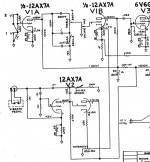A 6n2p is equivalent to an ECC83 which is the British 12AX7. Only thing is the heater wiring is between 4&5 with pin 9 as a screen, not the heater centre point.
So in short a 6n2p is an 12AX7 with 6.3 volts heaters in parralel between pins 4 & 5 NOT 4, 5 and 9. I incluse the data sheet for your replacement;
So in short a 6n2p is an 12AX7 with 6.3 volts heaters in parralel between pins 4 & 5 NOT 4, 5 and 9. I incluse the data sheet for your replacement;
Attachments
I have knowledge of the heater wiring, I was concerned that the 2n6p would not withstand the direct 410v as I never saw that direct voltage on that tubeA 6n2p is equivalent to an ECC83 which is the British 12AX7. Only thing is the heater wiring is between 4&5 with pin 9 as a screen, not the heater centre point.
So in short a 6n2p is an 12AX7 with 6.3 volts heaters in parralel between pins 4 & 5 NOT 4, 5 and 9. I incluse the data sheet for your replacement;
It is not 410V across the tube as the cathode is at 215V ...
Anyway , 6n2p is not exactly the same , like other russian copies of western tubes , just the mu is . You should measure what DC voltages you get and if it perform the same
Anyway , 6n2p is not exactly the same , like other russian copies of western tubes , just the mu is . You should measure what DC voltages you get and if it perform the same
The voltages between the cathodes and the anodes of V2 in the schematic are 208 V (left side section) and 197 V (right side section). Both are well within the limits of the 6N2P and the 12AX7, so that's no problem, like Depanatoru already wrote.
But maybe the maximum heater to cathode voltage is a problem. For the 12AX7 that maximum is 180 V. For the 6N2P that maximum is only 100 V.
The cathode of the right side triode sits at 213 V, so already over 180 V. But maybe the filament supply is lifted up in this amplifier (or, if not, maybe the designers knew that a 12AX7 can withstand this). But I would not count on a 6N2P being able to withstand this.
But maybe the maximum heater to cathode voltage is a problem. For the 12AX7 that maximum is 180 V. For the 6N2P that maximum is only 100 V.
The cathode of the right side triode sits at 213 V, so already over 180 V. But maybe the filament supply is lifted up in this amplifier (or, if not, maybe the designers knew that a 12AX7 can withstand this). But I would not count on a 6N2P being able to withstand this.

